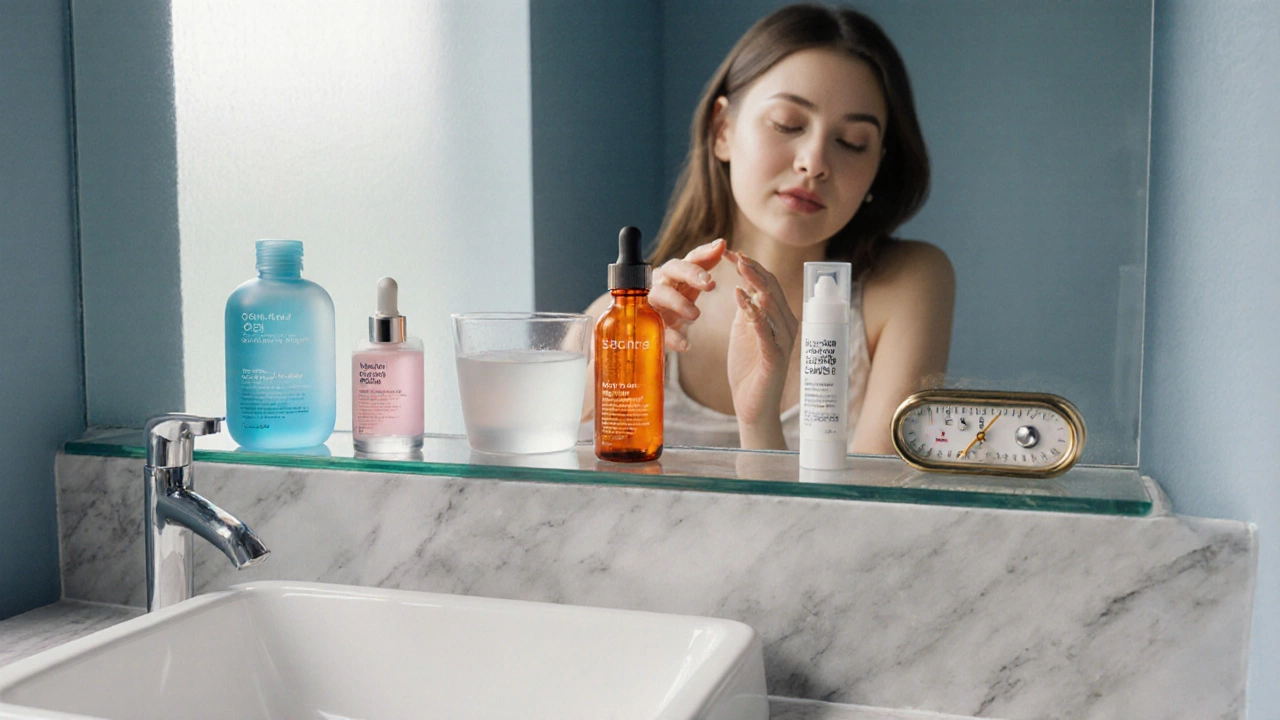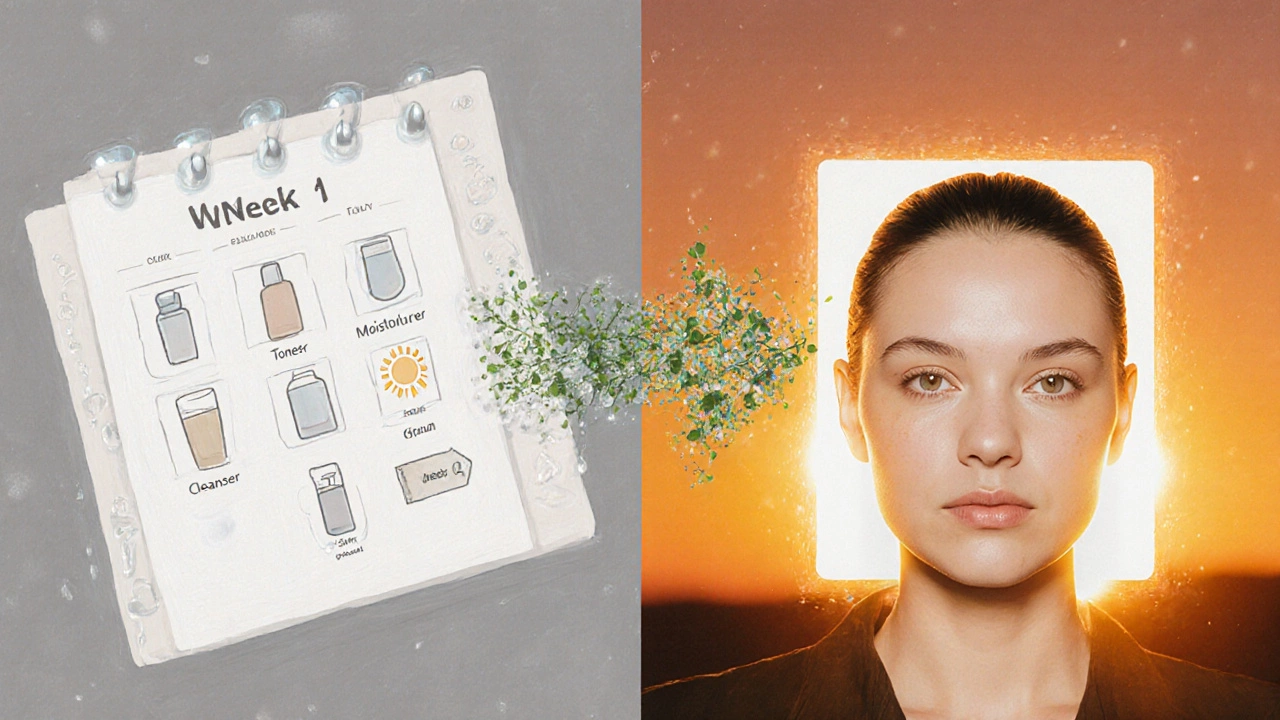
Skin Care Routine Builder
Select Your Skin Type
Oily / Acne-Prone
Excess sebum, prone to breakoutsDry / Dehydrated
Lack of moisture, flaky skinSensitive
Reactive skin, easily irritatedCombination
Mix of oily and dry areasYour Personalized Daily Routine
Morning Routine
Evening Routine
Key Ingredients for Your Skin Type
| Ingredient | Benefit | Best For |
|---|
When you hear the phrase perfect daily skin care routine, you probably picture flawless skin after just a few weeks. The truth is, a routine isn’t magic-it’s a series of tiny habits that add up. Below you’ll get a clear roadmap you can follow tomorrow morning, see why each step matters, and learn how to tweak it for oily, dry, sensitive or combination skin.
Why a Structured Routine Beats Guesswork
Most people treat skin care like a random experiment: they grab the first product on the shelf, hope it works, and switch every few weeks. That churn creates confusion and often irritates the skin barrier. A well‑ordered routine does three things:
- Preserves the skin barrier by keeping pH balanced and avoiding over‑exfoliation.
- Ensures active ingredients are delivered at the right time, maximizing absorption.
- Builds consistency, which is the only real driver for long‑term results.
Think of skin like a garden. Water, nutrients and sunlight each have their place; dump them all together and the plants wilt.
Core Components of a Perfect Daily Skin Care Routine
Every routine, no matter the skin type, revolves around six core components. Each component is a cleanser - a product that removes dirt, oil and makeup without stripping natural lipids, toner - a liquid that restores pH and preps skin for actives, serum - a concentrated formula targeting specific concerns like brightening or anti‑aging, moisturizer - a barrier‑locking cream or gel that seals in hydration, sunscreen - a broad‑spectrum SPF 30+ product that protects against UV‑induced damage, and finally exfoliator - a chemical or physical agent that removes dead cells, used 1‑3 times weekly. Optional extras like eye cream - a lightweight formula for the delicate eye area can be added based on personal concerns.
Step‑by‑Step Morning Routine
Morning is all about protection and prep. Follow these steps in order:
- Cleanse. Use a gentle, sulfate‑free cleanser that matches your skin type. For oily skin, a foaming gel (pH 5.5) works best; for dry skin, a cream‑based cleanser keeps lipids intact.
- Tone. Apply a hydrating toner with ingredients like rose water or glycerin to rebalance pH after cleansing.
- Serum. Choose a antioxidant serum. Vitamin C (10‑15% L‑ascorbic acid) brightens and neutralizes free radicals generated overnight.
- Moisturize. Pick a lightweight moisturizer with hyaluronic acid for dry skin, or a gel‑cream with niacinamide for oily/combo skin.
- Sunscreen. Finish with a broad‑spectrum SPF 30+ (mineral or chemical). Apply 2mg/cm² - roughly a nickel‑size dollop for the face.
Skipping sunscreen is the single biggest mistake anyone makes. UV‑A rays penetrate clouds and glass, causing collagen breakdown even on overcast days in Auckland.

Step‑by‑Step Evening Routine
Evening is repair mode. You have a longer window for actives that might be photosensitive.
- Double cleanse if you wear makeup or sunscreen. First, use an oil‑based cleanser to dissolve lipophilic residues, then follow with your regular water‑based cleanser.
- Tone again, this time you can opt for a calming toner with chamomile or centella asiatica.
- Targeted serum. Use a retinol (0.3‑0.5%) or peptide serum for anti‑aging, or a niacinamide (5%) serum for barrier support.
- Eye cream. Pat a small amount of peptide‑rich eye cream around the orbital bone.
- Moisturizer. Consider a richer night cream with ceramides and squalane to lock in moisture.
- Exfoliate (2‑3×week). On non‑retinol nights, incorporate a chemical exfoliant (e.g., 5% glycolic acid) after serum and before moisturizer.
Retinol and acids don’t play well together; keep them on alternate evenings to avoid irritation.
Customising the Routine for Your Skin Type
Not all skin is the same. Below is a quick cheat sheet.
- Oily / Acne‑prone: Foaming cleanser, niacinamide serum, oil‑free moisturizer, non‑comedogenic sunscreen. Add 2% salicylic acid as a spot treatment.
- Dry / Dehydrated: Cream cleanser, hyaluronic‑acid serum, richer moisturizer with ceramides, mineral sunscreen with added oat extract.
- Sensitive: fragrance‑free cleanser, soothing toner (panthenol), minimal actives - a low‑dose vitamin C and a barrier‑repair serum, mineral SPF, avoid alcohol‑based exfoliants.
- Combination: Gel cleanser, balanced toner, niacinamide + vitamin C serum (layered), lightweight moisturizer on T‑zone, richer cream on cheeks, broad‑spectrum SPF.
Patch‑test any new product for 48hours before full‑face use. This reduces the risk of flare‑ups.
Common Pitfalls and How to Avoid Them
Even with a perfect plan, mistakes creep in.
- Over‑exfoliating: More than three times a week can strip the lipid barrier, leading to redness and breakouts.
- Layering incompatible actives: Retinol + vitamin C together can cause irritation. Use vitamin C in the morning, retinol at night.
- Skipping moisturizer under sunscreen: Sunscreen alone can be drying, especially chemical formulas. Moisturizer keeps skin hydrated and improves SPF efficacy.
- Using the wrong order: Active serums need to go on clean, pH‑balanced skin. Always apply serums before heavier creams.
- Applying too much product: A pea‑size amount of serum and a nickel‑size amount of sunscreen is enough for the whole face.

Ingredient Spotlight: What to Look For
Understanding a few key ingredients helps you read labels fast.
| Ingredient | Primary Benefit | Ideal Skin Types |
|---|---|---|
| Niacinamide | Reduces inflammation, balances oil, improves barrier | All, especially oily/combo |
| Hyaluronic Acid | Attracts up to 1000× water, plumps fine lines | Dry, dehydrated |
| Vitamin C (L‑ascorbic acid) | Antioxidant, brightens, boosts collagen | Normal, dull, early signs of aging |
| Retinol (Vitamin A) | Stimulates cell turnover, reduces wrinkles | Normal, mature, acne‑prone (low concentrations) |
| Salicylic Acid (BHA) | Penetrates pores, clears excess oil | Oily, acne‑prone |
| Peptides | Signal proteins to repair collagen | All, especially mature skin |
When a product lists several of these actives, check the concentration. Too high a dose can irritate - for example, vitamin C above 20% may cause stinging on sensitive skin.
Building Your Routine Over 30 Days
Changing everything at once overwhelms the skin. Follow a 4‑week adoption plan:
- Week1: Stick to cleanse → tone → moisturize → sunscreen. No actives beyond a basic antioxidant serum.
- Week2: Introduce a targeted serum (vitamin C in the AM, niacinamide in the PM). Keep a diary of any redness.
- Week3: Add an exfoliant 2×week (chemical) and start a nightly retinol on alternate evenings.
- Week4: Evaluate results. If skin feels tight, increase moisturizer or lower exfoliant frequency. If breakouts improve, consider a stronger serum.
Consistency beats intensity. Most people notice smoother texture and a more even tone after 28days.
Frequently Asked Questions
Do I need a separate morning and night routine?
Yes. Morning focuses on protection (sunscreen) and antioxidant defense, while night emphasizes repair (retinol, richer moisturizers). Using the same steps both times can waste actives or cause irritation.
Can I skip the toner?
Skipping toner is okay if your cleanser is pH‑balanced, but a toning step helps restore the skin’s natural acidity and improves serum absorption, especially after a foaming cleanser.
How often should I exfoliate?
For most skin types, 1‑3 times per week is sufficient. Start with once a week and watch for irritation before increasing frequency.
Is sunscreen really necessary on cloudy days in New Zealand?
Absolutely. UV‑A penetrates clouds and can reflect off water and concrete. Even in Auckland’s winter, an SPF30+ shield prevents premature aging.
What’s the best way to layer products?
Start with the thinnest texture: cleanser → toner → lightweight serum → thicker serum → eye cream → moisturizer → sunscreen (morning) or night cream (evening). Let each layer absorb for a few seconds before adding the next.